Abstract
The inadequate disposal of household appliances by consumers and industries have annually been generating enormous amounts of polymeric waste (PW). So, the interest in reuse of PW in civil construction has increased. The production of new cementitious materials, such as concrete with PW, proves to be a promising solution to inappropriate disposal of this waste. In this study, self-compacting concrete (SCC) was developed with partial replacement of the coarse aggregates by polymeric waste (PW) from the recycling of refrigerators. In the SCC reference mixture, Portland cement, silica fume, sand, gravel and superplasticizer were used. The study also grouped the gravel as replaced by 5%, 10%, 15% and 20% of PW. In order to analyze the samples, the following tests were used: spreading, viscosity, passing ability, compressive strength, tensile strength, microstructure, modulus of elasticity, specific gravity, absorption, voids index and electrical resistivity. The SCC found showed adequate homogeneity and viscosity, staying within the normative parameters. The mechanical resistance was above 20 MPa; specific mass between 1870 to 2260 kg/m3; modulus of elasticity ranged from 34 to 14 GPa; and electrical resistivity between 319 to 420 ohm.m. Due to the mechanical resistance, the SCC with PW can be used for structural purposes and densely reinforced structures such as pillars, beams and foundation elements.
1. Introduction
Nowadays, concrete is the most widely used construction material worldwide. Technological advances have enabled several advances in the sustainable construction market that has become an indispensable part of civilization [1]. The rapid growth of the world population and the spread of urbanization drove the development of the civil construction industry. As such, there exists a great demand for natural aggregates, such as sand and gravel. The rate of extraction of natural raw materials is greater than the resources’ natural recovery, and this became an environmental problem. For that reason, it is essential that alternative sources of recycled materials be used in concrete [1].
Electronic products are an integral part of people’s daily lives and promote more comfort, safety and ease of obtaining information. The waste generated by electronic products can cause damage to human health and require care during disposal to avoid adverse impact. The treatment of these residues is complex because they often contain toxic chemical elements such as lead, cadmium, mercury, belirium and phosphorus compounds. However, waste of this nature can be incorporated into concrete to aid environmental sustainability [2].
The category of electrical and electronic equipment waste is one of the fastest growing around the world [2]. The annual consumption of plastic material in the world grew rapidly from 1.5 million tons in 1950 to approximately 322 million tons in 2015 [3]. This challenging reality demands a sustainable approach to preserve the environment by infrastructure projects, conservation of natural resources and reduction of waste disposed of in inappropriate landfills [4].
Plastic or material composed of polymers is the artificial material most commonly used in the world after steel and cement [5]. According to the nature of polymeric waste, plastic materials can be treated in three ways: landfill, incineration and recycling. Besides, the use of plastic products can only be reduced to a certain extent. So, it is necessary for recycled plastic materials to help decrease the demand for raw materials [6].
In particular, plastic materials disposal into landfills produce greenhouse gases; however, using different solid waste polymeric recycling methods can be applied to convert them into sustainable applications. In addition, the large-scale disposal of plastic material in these places represents a great waste of strong energy and raw materials [7].
The waste used in this research comes from the recycling of crushed refrigerators, which is an abundant and low-cost resource. The use of self-compacting concrete (SCC) with polymer waste in the fresh state causes loss of workability, passing ability and ability to fill in the form of work [8]. In the hardened state, the polymer waste tends to decrease the mechanical strength, stiffness and specific gravity of the concrete, but tends to increase the porosity and/or void index [9]. Plastic fibers in percentage values close to 3% by volume can increase the mechanical strength. The use of plastic waste in particle format tends to worsen the workability of the concrete in the fresh state [10]. The use of particulate plastic waste in certain substitution ranges as an aggregate in the concrete can promote better values of workability and spreading [11]. However, the mechanical resistance is compromised by the incorporation of plastic waste [12]. The use of electronic waste can promote mechanical resistance in certain replacement ranges when using aggregates in concrete and is an appropriate disposal method for this waste [13].
SCC with polymeric residues in certain substitution ranges presents characteristics in the fresh state like loss of workability and segregation of the aggregates. SCC with polymeric residues presents characteristics in the fresh state, such as loss of workability and segregation of the aggregates in certain substitution ranges. In the hardened state, when increasing the rate of substitution of the natural aggregate, for the polymeric aggregate there occurs a loss in mechanical resistance and alteration of its physical properties [14]. It happens when replacing the fine aggregate with plastic waste.
In short, self-compacting concrete (SCC) with polymeric residues is a composite that integrates the workability qualities of SCC with the reuse of polymeric residues that would be discarded and rendered useless in the environment [12]. Studies also have been showing that an SCC with polymeric residues is feasible to be produced and used on a large scale in the composition of structural and non-structural elements.
There are several situations in civil construction where structural elements, such as beams, pillars and slabs, need to be rehabilitated or recovered. Old structures or structures that have received some types of damage or structures that must handle new loads often must be reinforced to extend their useful life. Fortunately, there are different techniques that have been developed to strengthen structural members [15]. It is precisely in this context that SCC is frequently used; its unique characteristics are explored in order to supply the needs that this unconventional application can offer.
SCC is a special type of concrete that can be applied in various situations in civil construction. The repair and rehabilitation of structures is a field of application of the SCC due to its characteristics of good workability, remarkable filling and passage capacity that make SCC an ideal material for the rehabilitation of damaged concrete parts, restoring the continuity and homogeneity of structural elements [16]. In addition, the SCC flows through the reinforcements without causing a vacuum in the element or any discontinuity in the interface between the existing and the new concrete. Therefore, the use of SCC in most situations of reinforcement and repair or rehabilitation is desirable. In a study developed by [17], they used SCC in the reinforcement of damaged, reinforced concrete beams undergoing a bending test. The study considered damaged beams in which a U-shaped reinforced concrete SCC liner or liner was made. It can be seen that the use of SCC for this type of application is a promising rehabilitation technique. In a study developed by [18], they investigated the reinforcement of reinforced concrete beams that were damaged and later reinforced and by coatings composed of SCC under different support loads. In this scenario, the author can conclude that the use of such a technique generates substantial benefits to the strength of the restored beam.
This study investigates an alternative to producing SCC with polymeric waste, by partial replacement of the coarse aggregate while the substitution of the fine aggregate is usually used. In addition, waste recycling of refrigerators can be obtained from a large amount of waste worldwide. So, the effect of partial substitution of the coarse aggregate (CA) with polymeric waste (PW) in SCC is explored and its characteristics in the fresh and hardened state are evaluated to verify its behavior and possible trends. Besides, the experimental results of the mixtures are compared with each other in order to evaluate the achievement of the SCC with PW partially replacing the CA, and then characterizing the main properties in the fresh and hardened states. No other studies were found that use exactly the residue used in this study, which is a hodgepodge of polymers from the recycling of refrigerators.
2. Materials and Experimental Program
The materials used in this study were selected and characterized before the concrete mixtures were made. After the production of the concretes, they were subjected to tests in the fresh state and shortly after curing the concretes were subjected to tests in the hardened state. These procedures were carried out following normative recommendations and were carried out at the Construction Materials Laboratory of the Federal University of Itajubá, UNIFEI.
2.1. Materials
The Portland cement used was of the high initial strength type supplied by the company Votorantim Cimentos Brazil ltda. It has a specific mass of 3.09 g/cm3; unit mass of 1.04 g/cm3; specific area of 350 m2/kg; compressive strength at 7 days of 47.5 MPa and at 28 days of 56 MPa; as well as starting time of 140 min and final of 205 min—this information was provided by the supplier.
Silica fume is a fine powder that was used in SCC mixtures to react with calcium hydroxide and produce concrete with greater mechanical resistance, and to increase cohesion and reduce the sensitivity of the change to the addition of water. The silica used has a specific mass of 2.20 g/cm3, a silica oxide content greater than 90% by mass and a specific surface area of approximately 19,000 m2/kg; the spherical particle shapes and the silica fume used in this study were supplied by Tecnosil Ltda and all characterization information was provided by the company.
The superplasticizer (SPA) was the only chemical additive used in the SCC mixtures, provided by the company Silicon ltda. The SPA reduces the demand for water to achieve adequate workability [19]. It has a pH of 3.5 to 5.5, has a brown and honey color, a specific mass from 1.06 to 1.10 g/cm3 and is soluble in water; this information was provided by the supplier.
Local sand and gravel were used as aggregates. Most of the sand in the southern region of Minas Gerais, Brazil, comes from river sources and has a major composition of sedimentary rocks, such as sandstone and quartzite. The gravel comes from quarries and has mostly a limestone and quartzite composition [20]. The water (potable) used came from the public supply network in the southern region of Minas Gerais, Brazil, supplied by the company COPASA.
2.2. Polymeric Waste
The polymeric residues used in the research come from the recycling of unused and discarded refrigerators. The Company Fox Ltda collects several appliances and electronics for each equipment, proceeds with a type of recycling of the constituent materials. The use of refrigerator residues was chosen to partially replace the coarse aggregate, because these residues are difficult to recycle by other conventional methods, as it consists of several types of polymers. Table 1 shows a summary of the sequence of steps for recycling refrigerators adopted by Fox Ltda.

Table 1.
Tests for the characterization of the aggregates.
In Step A, the removal and separation of parts in good condition occurs; in Step B, the refrigerators are prepared and positioned for recycling; in Step C, removing greenhouse gases from the refrigerator; in Step D, the refrigerator is sent for crushing; in step E, the refrigerator is crushed; in Step F, the materials are separated; in step G, the material is stored; and in step H, tubes and tanks for the treatment of greenhouse gases are shown. The PW used in this study is only plastic parts of the refrigerators and does not contain metallic or ceramic materials common in refrigerators. All waste sorting is carried out in stages organized by the company Fox ltda.
It is worth highlighting the separation method used in the production of PW. Before Step G, the ferromagnetic metals are separated by a magnetizing effect, and then the material is sent to a centrifugation tank with water. As a result, all metals are separated from the PW. Still in this stage, the most dense polymers (used in this work) from the lightest are separated by decantation.
The PW used in this study as an aggregate of concrete was collected in the form shown in Step G of Figure 1. It is possible to verify that the PW is formed by several polymers, a fact that makes it difficult to recycle by conventional methods, because the cost of separation in each singular polymer would be impracticable.
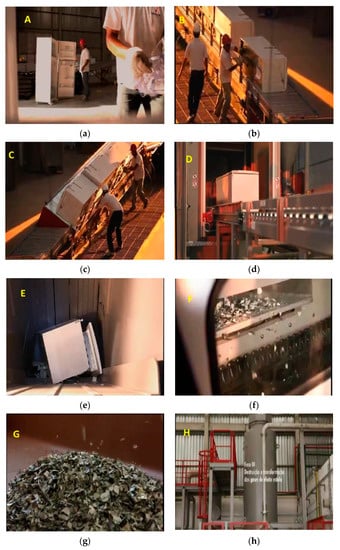
Figure 1.
Refrigerator recycling steps by Fox Ltda industries: (a) initial refrigerator cleaning; (b) positioning the refrigerator for recycling; (c) removal of greenhouse gases; (d) refrigerator is sent for crushing; (e) refrigerator crunch; (f) separation of crushed materials; (g) storage of materials; (h) tanks for the treatment of the gases.
The tests described in Table 1 characterize the aggregate materials used in this study. It allows to dose the concrete mixtures by following the procedures of the adopted mixing method.
In the granulometry tests, approximately 500 g of the sample were separated and kept in an oven for 24 h at a temperature of 105 ± 5 °C. After this period, the dry sample was sieved using sieves of the normal series. Through the weight of the material retained and accumulated in the sieves, the graphs were drawn and the indexes of fineness modulus and maximum diameter of the aggregate were calculated. In the specific mass, unit mass and absorption tests, 3 samples were separated by batches of concrete, in which the saturated mass was measured at room temperature of 24 ± 2 °C, the dry mass after 24 h in the oven at 105 ± 5 °C, and the mass submerged in drinking water at a room temperature of 24 ± 2 °C.
For the infrared spectroscopy tests, fragments of the lamellar-shaped sample of dimensions 1 cm × 1 cm and thickness of 3 mm were separated. A Trasffinity-1S spectrometer with coupled total reflectance attenuation was used by means of which it was possible to assign the absorption bands characteristic of the spectrum for each tested residue.
The classification as a solid waste by ABNT NBR 10004: 2004 was carried out by means of visual inspection and through which the waste can be classified as Class II or III and Code A007 or A008; the wastes from the polymerized process were plastics and rubber wastes.
2.3. Mixing Method
The mixtures of the concrete were based on guidelines from [21] and studies carried out by [22]. Thus, the ideal mixture mix for the concrete was achieved after several experimental tests that included a water/cement ratio of 0.42, cement consumption close 450 kg/m3 and partial replacement of gravel by PW up to 20%. The chemical additive SPA was introduced in the mixture in an amount of 1.5% with respect to the cement mass to ensure the ability to flow, resist and segregate the SCC. Silica fume was also used as a fine material to ensure better mechanical strength and workability. As can be seen in Table 2, the control mix without PW (M0) was developed for comparison between the mixtures with PW that were dosed in mass and with respect to gravel. There were four mixes with PW: 5% PW (M5), 10% PW (M10), 15% PW (M15) and 20% PW (M20). Figure 2 also shows the separated materials for the concrete mixes.

Table 2.
Mixture proportions of the self-compacting concrete.
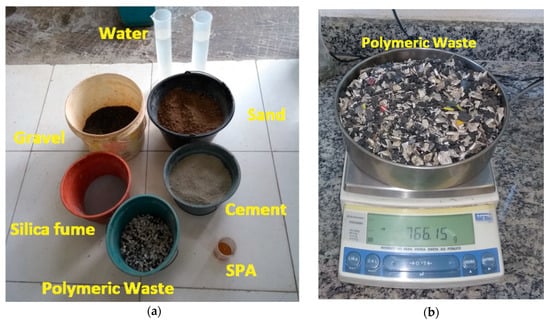
Figure 2.
Agglomerate materials: cement and silica; natural aggregates: sand and gravel; artificial aggregates: polymeric waste and water. (a) All materials used in the mixtures and (b) weighing of the polymeric waste for concrete mixing.
2.4. Preparation of the Recycled Aggregates and Concrete Specimens
For use in concrete mixtures, the PWs were separated and cleaned with water in order to remove any unwanted impurities or reactive materials. After the granulometry test, the PWs were also sieved in the granulometry between 4.8 to 9.5 mm to correspond to the granulometry of the gravel used and the removal of the powdery material. Therefore, no special treatment was performed for its use in the SCC. Each concrete mix was molded in cylinders 100 mm × 200 mm and then unmolded after 24 h and placed in a room with a controlled humidifier for curing at room a temperature of 24 ± 2 °C until the mechanical tests of 7 and 28 days according to [23]. The materials for making the SCC were mixed in a concrete mixing machine model CSM 145/CS 145 with rotation on an inclined axis. First, fine-grained aggregates such as cement, silica fume and sand plus half of the mixing water and the SPA were added. Soon afterwards, the coarse-grained materials, such as the crushed limestone, PW and the rest of the water, were added. Each stage lasted approximately 10 min.
2.5. Testing Procedures
Fresh state test: The tests in the fresh state of the SCC were carried out in accordance with [24,25,26]. The tests carried out were as follows: determination of spreading, the flow time (T500) that measures satisfactory flow capacity, fluidity, resistance to segregation and exudation of the SCC. A viscosity determination test (V-funnel) was also carried out, which measures the viscosity and fluidity of the SCC. A test of determination of the passing ability (L-box) that measures the fluidity, cohesion and passing ability of the SCC was also carried out.
Hardened state test: Compression strength tests were performed at 7 and 28 days of cure and tensile strength at 28 days of cure. A hydraulic loading machine from the brand Time testing machines (universal electric and hydraulic testing machine, and a computer-controlled servo), model WAW-1000C, with a load capacity 1000 ton were used for the tests. The tests were performed according to the respective standards [23,27].
Dynamic elastic modulus (Ed) tests were carried out with the impulse excitation technique (TEI) at 28 days of cure, based on a previous study [28]. Using the method proposed by [29], the respective static elastic modulus (Ec) was also calculated. The model proposed by [29] makes use of Equation (1), in which the static elastic modulus is calculated by the dynamic elastic modulus.
where k is a constant that depends on the units used (k is equal to 0.107 when the module is given in Pa and the density in kg/m3) and is the density of the concrete.
The electrical resistance test of the concrete was also performed at 28 days of curing, in which the test piece (100 mm × 200 mm) is positioned between two resistors and is then subjected to the passage of electrical current. The potential difference and the current are recorded and used to calculate the electrical resistivity, according to the procedure of [30].
Specific mass, absorption and voids index tests were performed according to [31] for the specimens (100 mm × 200 mm) of 28 days of age. In this test, the specimens were immersed in water at a temperature of 20 ± 2 °C for 24 h and the immersed mass of the samples were measured with a hydrostatic balance. Then, the saturated mass of the samples in a saturated surface situation was measured. Finally, the samples went to an oven at 100 ± 5 °C for 24 h and the dry mass of the sample was measured. Microstructure analyses were performed using fragments selected from the SCC samples. The equipment used for the analysis of the microstructure was a scanning electronic microstructure (SEM) type, using model equipment (Zeiss, model EVO MA15).
3. Results and Discussions
3.1. Characterization of the Materials
The polymeric residue (PW) was used as a partial substitute for the coarse aggregate (CA). Figure 3a shows six main types of waste particles that appear in the samples and that are irregular and lamellar in shape. These six particles were chemically characterized, and the result is shown in Table 3 and Figure 3b; it is together with the granulometry of the fine aggregate (FA) and coarse aggregate (CA). The chemical composition and visual aspects of the PW are shown in Table 3, where it is possible to observe that the PW is formed by a set of particles of polyurethane (PU) and polyester (PES) in varying percentages. To carry out this characterization, 5 kg of the sample were separated. Table 4 shows the result of the granulometry test, Fineness module, Specific gravity, Absorption and Classification for PW, FA and CA.
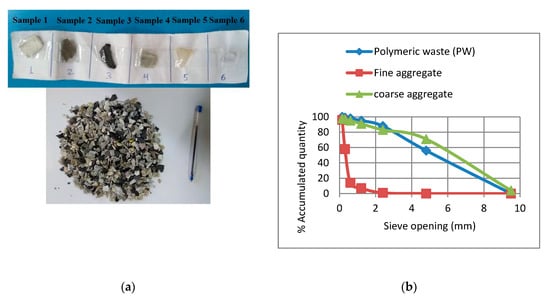
Figure 3.
(a) Polymeric waste (PW) samples classified by visual characteristics; and (b) the granulometry distribution of the aggregates.

Table 3.
Characterization of the polymeric residue contained in a 5 kg sample.

Table 4.
Properties of the polymeric waste (PW), fine aggregate and coarse aggregate.
3.2. SCC in Fresh Condition
Figure 4 shows a summary of the results in the fresh state for the SCC. In general, it is possible to observe a decrease in fall time or plastic viscosity and an improvement in passing ability. By the slump flow test, Figure 4a, the SCC is classified as SF3, being indicated for structures with a high reinforcement density and/or in a complex architectural form; for example, pillar walls and diaphragm walls [32]. In this test, an increase in the spreading diameter of 1% for M5, 2% for M10 and M15 and 6% for M20 was observed in relation to the reference sample. In the Flow time (T500) test, Figure 4b, the SCC with residue is classified as VS1, being suitable for applications such as beams and columns [32]. The spreading time decrease by 11% for M5, M10 and M15 and 22% for M20. In the plastic viscosity test, Funnel V (Figure 4c), the SCC is classified as VF1 [26]. Furthermore, there was a loss in viscosity represented by the variation in the fall time; the decreases were 6% for M5, M10 and M15 and 25% for M20. In the passage skill test, box L (Figure 4d), the SCC is classified as PL2, with an H1/H2 ratio greater than 0.80 [25]. It is recommended for structural elements with a high reinforcement density and inlays; for example, diaphragm walls, pillar walls and the precast and exposed concrete industries [25]. In this test, there was an increase in the passing ability represented by the increase in the ratio between H1 and H2, with an increase of 6% for M5, 12% for M10 and 15% for M15 and M20.
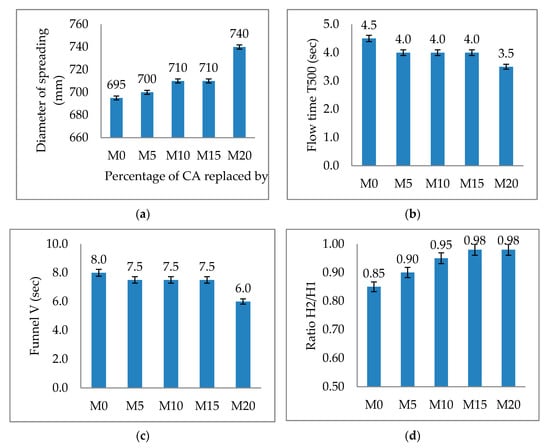
Figure 4.
Behavior of the self-compacting concrete (SCC) by incorporation of PW: (a) slump flow test; (b) flow time (T500) test; (c) flow time (funnel V) test; and (d) passing skill (L-box) test.
Studies carried out by other authors [33,34,35,36] obtained results that, in general, have the same tendency to improve the workability of the SCC with waste of polymeric origin, in certain incorporation ranges. The SCC workability gain due to the increase in the incorporation of PW can be attributed to the replacement of the natural aggregate by PW. The PW has less surface roughness and less weight per unit area, and as a result there is less internal friction on the fresh concrete [33]. For [35], the different properties of polymeric residues, such as surface texture, shape and size, can influence the divergence of results found in the literature. For [34], the shape of the particles that replace the natural aggregates is the main variable that influences the behavior in the fresh state of the SCC.
The most relevant characteristics that certainly must be taken into account to explain the behavior of SCC with PW is the surface roughness of the residue and its low specific gravity when compared to natural gravel, as well as its use in the form of particles to replace the natural coarse aggregate [37]. The PW has a smooth and polished surface compared to the natural gravel surface, which is rough and irregular. Thus, the surface of the PW does not adhere properly with the mixing water and impairs the formation of the transition zone on the interface. The PW has a hydrophobic behavior, as rubber, and acts to reduce the concrete flow stress [37]. Images of the moment of execution of the tests in the fresh state are shown in Figure 5.
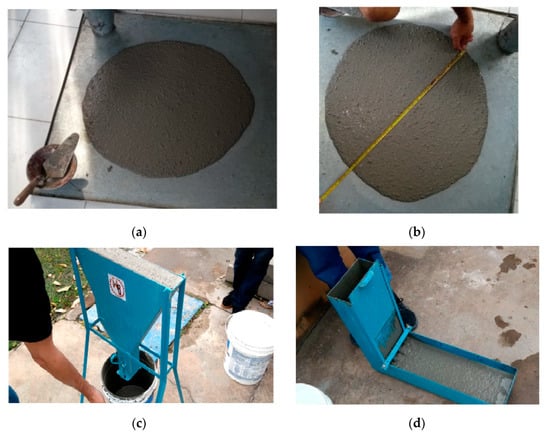
Figure 5.
Fresh tests for the SCC with PW: (a) slump flow test for M5; (b) slump flow test for M10; (c) flow time (funnel V) test; and (d) passing skill (L-box) test.
3.3. SCC in Hardened Condition
3.3.1. Mechanical Resistance and Microstructure
Based on the results of the compressive strength shown in Figure 6a, the replacement of crushed stone by PW causes a decrease in the axial compression strength in concrete with 7 days of curing, as the PW content is increased. This represents a decrease in relation to the reference mixture of approximately 28% for M5, 43% for M10, 56% for M15 and 63% for M20 (Figure 6a). Meanwhile, the compressive strength at 28 days of curing decreased from 28% for M5, 33% for M10, 50% for M15 and 57% for M20. Despite the drop in mechanical strength presented, all SCC can be classified as concrete for structural purposes, according to ABNT NBR 8953: 2015 [38].
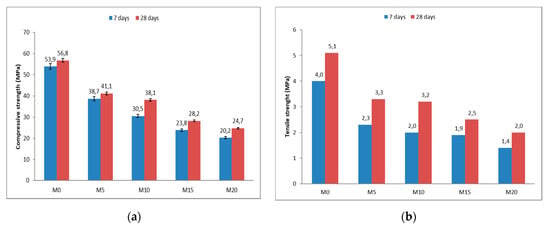
Figure 6.
Mechanical resistance of the SCC by incorporation of PW: (a) compressive strength and (b) tensile strength.
Figure 6b shows the tensile strength result of the SCC with PW. There is a decrease in tensile strength as the substitution of PW increases, representing a decrease with respect to the reference mixture at the age of 7 days equal to 43% (M5), 51% (M10), 53% (M15) and 65% (M20); and at the age of 28 days, a decrease equal to 36% (M5), 37% (M10), 50% (M15) and 61% (M20), respectively.
The results show that the replacement of natural gravel by PW significantly reduces the compressive strength and tensile strength of the concrete. This is in accordance with several studies in the same line of research and which showed a tendency to decrease resistance to axial compression with the incorporation of polymeric residues [11,37,39,40,41,42,43,44,45].
Certainly, the decrease in compressive strength is linked to the physical nature and chemical composition of the PW, which does not adhere properly to the cement mortar, as can be seen in Figure 7a,b, which shows the microstructural analysis for all SCC mixtures. It is possible to observe that, as the PW content increases, there is a deterioration in the microstructure with the appearance of voids, cracks and lack of adhesion between the PW and mortar, especially for M20. The chemical composition of the PW is basically formed by the polymers, as can be seen in Table 3, in the infrared spectroscopy test, in which compounds such as particles of polyurethane and polyester have less mechanical strength than natural gravel. Thus, the presence of an aggregate with less mechanical resistance and which does not present surface adhesion compromises the mechanical resistance of the SCC. In Figure 7, the scanning electron microscopy analysis of the transition zone at the interface between the aggregate and cement paste is shown. It is possible to observe that there is a lack of adherence between the two phases.
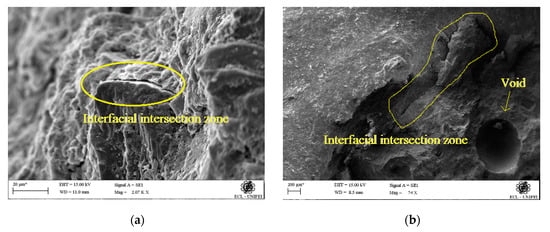
Figure 7.
Scanning electronic microstructure (SEM) of the SCC with PW: (a) sample with 15% PW and (b) sample with 20% PW.
In short, the significant loss of mechanical strength can be related to the gradual replacement of a coarse aggregate (crushed stone) of a relatively high strength and specific gravity by PW of a low resistance and low specific gravity that have different behaviors and different chemical compositions [44]. The fact that the polymeric waste has a low adhesion surface with concrete makes the material as a whole less resistant [40]. Figure 8 shows broken specimens; it is possible to observe the PW in its composition.
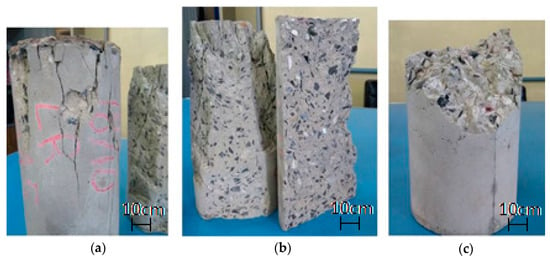
Figure 8.
SCC samples after destructive testing. Axial compression test (a); diametrical tensile test (b); and broken sample section (c).
3.3.2. Modulus of Elasticity.
As shown in Figure 9, the dynamic elastic modulus (Ed) and static elastic modulus (Ec) of the SCC with PW tends to decrease as the content of the replacing gravel with PW increases. There was a decrease in the dynamic elasticity module by 1% for M5, 12% for M10, 5% for M15 and 58% for M20 and for the static module by 1% for M5, 13% for M10, 1% for M15 and 63% for M20; that is, the concrete becomes less rigid and these results are proportional to those found in the studies of [10,12,37,45]. This behavior can be explained by the incorporation of PW in concrete, which is a less rigid aggregate than natural gravel [46]. It is clear that the dynamic elastic modulus is greater than the static elastic modulus in all situations tested. These results are in accordance with the viscoelastic behavior of the concrete; that is, its reaction varies according to the deformation rate during a test. In the Ed tests the strain rates are higher than in the Ec test, so in the Ed test there is less time for stress accommodation and the greater the slope of the stress–strain curve [47].
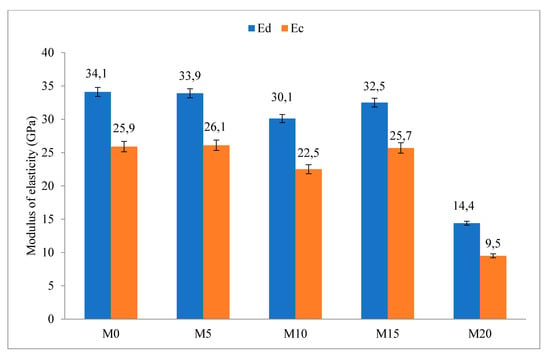
Figure 9.
Dynamic and static elasticity modules for the SCC with PW.
A study by [45] makes a comparison between conventional concrete, conventional SCC and polymer SCC. In this study, the author was able to verify that the SCC with polymer obtained results of a lower dynamic elasticity module when compared to other concretes. The reduction in the elastic modulus of the SCC certainly occurs due to the low modulus of elasticity of the polymer added to the concrete.
The modulus of elasticity is the measure of the stress–strain curve of a material subjected to stress. The greater the stiffness of a material, the greater its modulus and the more inclined the stress versus strain curve. Fragile materials with a large modulus allow fewer deformations when compared to ductile materials that are less rigid [48]. When the less rigid (ductile) material is added to concrete, such as plastics and rubber, the stress–strain curve is modified in the elastic region, becoming less inclined in this stretch and thus decreasing the concrete module [46].
3.3.3. Specific Mass, Absorption and Voids Index
As shown in Figure 10a, the specific gravity (ρ) of the SCC with PW decreases with the increase in the replacement of crushed stone by PW. Similar results for the specific gravity, absorption and void index were found in studies of [35,37]. The specific gravity tends to decrease because, according to [49], the density of the plastic aggregate in general is 70% lighter than the natural aggregate if you compare the specific gravity of the plastic aggregate used with the sand, 1.34 g/cm3 to 2.61 g/cm3, respectively. The decrease in specific gravity of the mixtures with PW in relation to the reference mixture is 1.6% to M5, 3.1% to M10, 5.6% to M15 and 18.6% to M20.
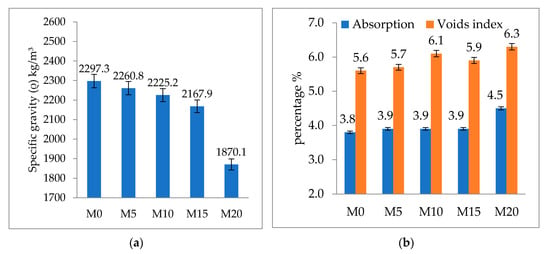
Figure 10.
Physical characterization tests of the SCC with PW: (a) specific gravity for the SCC with PW and (b) water absorption and void index for SCC with PW.
Figure 10b shows that the values obtained for the absorption and voids index increase with the addition of PW. Regarding the reference mixture, the following rate of increase occurs for the absorption test: 2.6% to M5 and M15, and 18.4% to M20. For the void index tests: 1.8% to M5, 8.9% to M10, 5.2% to M15 and 12% to M20. According to the criteria for assessing the quality of the concretes presented in Table 5, the SCC can be classified as durable, and only the M20 mixture as the water absorption that exceeds the value of 4.2% being classified as normal.

Table 5.
Criteria for assessing the quality of concrete [49].
3.3.4. Electrical Resistivity
As shown in Figure 11, the electrical resistance of the SCC with residue tends to decrease as the content of replacing gravel with PW increases. With respect to the reference mixture, the results show an increase of 109% to M5, 173% to M10, 145% to M15 and 176% to M20.
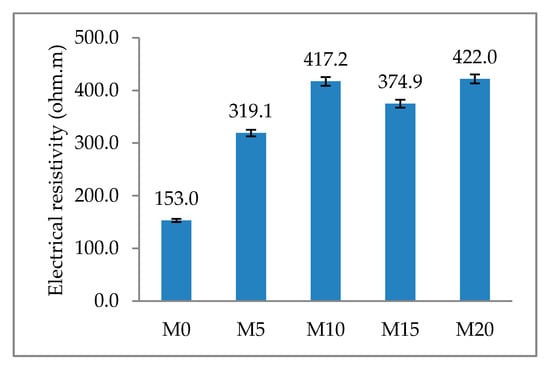
Figure 11.
Electrical resistivity of the SCC by incorporating PW.
In general, the increase in the electrical resistivity of a material represents the increase in the resistance of this material in relation to the passage of electrical current. Thus, the more insulating the material in the concrete composition, the greater its electrical resistivity [12].
Concrete is a composite material and its characteristics are the result of the interaction of its constituents. Thus, when a quantity of non-conductive material, such as PW, is incorporated, it is natural to have a material with less electrical conductivity as a product. In other words, concrete becomes a more electrical insulator, more resistant to the passage of electrical currents. These results are proportional to those found in the studies of [20,21].
The electrical resistance of the concrete is linked to its durability. Through Table 6, we observe that the corrosion probability of the concrete with PW is negligible since all mixtures with PW obtained a resistivity greater than 200 Ω.m.

Table 6.
Corrosion probability as a function of concrete resistivity.
4. Conclusions
This study sought to characterize the SCC with PW from the recycling of refrigerators. Since this polymeric waste is shown to be an environmental liability, we tried to use it as a coarse aggregate in the SCC. Throughout this study the various properties in the fresh and hardened state of the SCC with partial replacement of CA by PW were evaluated with five different mixtures. Thus, the following conclusions can be considered for the study: In the fresh state and compared to the reference mix, the SCC with PW resulted in a gradual decrease in viscosity with increased fluidity of 1% to 6%; decreased cohesion of 11% to 22%; and decreased in flow time of 6% to 25%. There is also an improvement in the passing ability of the SCC with increased PW incorporation of 6% to 15%. In the mixtures M5 to M20, the concrete remained stable and homogeneous. Therefore, PW as a CA can be used in SCC to improve the workability in the fresh state in densely reinforced structures, within the percentages used.
In the hardened state and compared to the reference mix, the SCC with PW showed a decrease in compressive strength in the order of 28% to 57%. However, it was possible to obtain strengths above 20 MPa after 28 days of curing, and a decrease in tensile strength by 36% to 61% with tensile strength values of 5 to 2 MPa at 28 days of curing.
There was a decrease in the dynamic elastic modulus from 34 GPa to 14 GPa with an increase in the incorporation of PW, which varied from 1% to M5 to 58% to M20 at 28 days of curing. Samples with 5% and 15% PW showed better results of the dynamic elastic modulus. The static elasticity module varies from 25.9 GPa to M5 9.5 GPa, which represents a percentage 1% to 63% decrease.
The specific mass decreased with the increase in the incorporation of PW, varying from 1870 to 2260 kg/m3, which represents a decrease of 1.6% to 18.9%. The concrete showed an increase in water absorption from 5.7% to 6.3% and an increase in the volume of voids from 3.9% to 4.5% after 28 days of curing. The sample with 20% PW showed better results in specific mass. The best results for the volume of several and incorporation of air were from samples M5. The electrical resistivity of the concrete increased from 109% to 176% with an increase in the incorporation of PW; the best results are from the M10 and M20 samples.
As for the objectives initially proposed, it can be said that it was possible to produce an SCC with this kind of polymeric waste. The main characteristics of the SCC were also characterized in the fresh and hardened state. It was possible to verify that the SCC produced shows itself in adequate contours of fluidity and cohesion to be applied in densely reinforced and prefabricated structures.
The mixtures developed as well as the characterizations performed were able to contribute to obtain a final product that met the normative expectations for an SCC with PW. This can be used in applications of non-structural and structural elements, namely, densely reinforced and prefabricated concrete structures. In addition, the final product resulted in a concrete with better electrical insulation, less rigidity and reduced weight per unit area.
We suggest future studies on concrete with polymeric residues of electronics that characterize durability use different types of particle sizes; in addition to varying the composition of the fine and coarse aggregates and the water–cement ratio. The application of this concrete in structural elements can be performed as a case study, as well as the simulation of complete structures using concrete with polymeric residues.
Author Contributions
Conceptualization, M.d.L.N.M.M.; L.R.R.d.S.; data curation, M.B.F.; M.H.B.d.S.; J.A.d.S.; L.R.R.d.S.; formal analysis, V.A.R.; L.R.R.d.S.; M.d.L.N.M.M.; methodology, L.R.R.d.S.; M.d.L.N.M.M.; writing—original draft, L.R.R.d.S.; P.C.; writing—review & editing, L.R.R.d.S.; P.C.; M.d.L.N.M.M.; visualization, M.d.L.N.M.M.; resources, M.d.L.N.M.M.; M.A.S.; funding acquisition, M.d.L.N.M.M.; V.C.d.S.; P.C.G.; validation, M.d.L.N.M.M. All authors have read and agreed to the published version of the manuscript.
Funding
This research was funded by Coordination for the Improvement of Higher Education Personnel (CAPES), Minas Gerais Research Foundation (FAPEMIG) grant number APQ-01301-15 and National Council for Scientific and Technological Development (CNPq) grant number 308021/2018-5. The APC was funded by Federal University of Itajubá (Unifei).
Acknowledgments
The Federal University of Itajubá (UNIFEI) for all support in laboratories and technicians and the company Tecnosil and Fox Industry Circular Economy for the materials donated to carry out this study.
Conflicts of Interest
The authors declare no conflict of interest.
References
- Shamili, R.; Natarajan, C.; Karthikeyan, J. An Overview of Electronic Waste as Aggregate in Concrete. World Acad. Sci. Eng. Technol. Int. J. Struct. Constr. Eng. 2017, 11, 1423–1427. [Google Scholar]
- Awasthi, A.K.; Cucchiella, F.; D’Adamo, I.; Li, J.; Rosa, P.; Terzi, S.; Wei, G.; Zeng, X. Modelling the correlations of e-waste quantity with economic increase. Sci. Total Environ. 2018, 613–614, 46–53. [Google Scholar] [CrossRef] [PubMed]
- PlasticsEurope. Plastics—The Facts. Plast Facts 2018, 2018, 38. [Google Scholar]
- Purushothaman, R.; Amirthavalli, R.R.; Karan, L. Influence of treatment methods on the strength and performance characteristics of recycled aggregate concrete. J. Mater. Civ. Eng. 2015, 27, 04014168. [Google Scholar] [CrossRef]
- Geyer, R.; Jambeck, J.R.; Law, K.L. Production, use, and fate of all plastics ever made—Supplementary Information. Sci. Adv. 2017, 3, 19–24. [Google Scholar] [CrossRef]
- Gertsakis, J.; Lewis, H. Sustainability and the Waste Management Hierarchy. A Discuss Pap waste Manag hierarchy its Relatsh to Sustain. 2003. Available online: https://www.sustainability.vic.gov.au/~/media/resources/documents/Publications%20and%20Research/Publications/Q%20-%20T/Publications%20Towards%20Zero%20Waste%20Sustainability%20and%20the%20Waste%20Hierarchy%202003.pdf (accessed on 24 June 2019).
- Lv, F.; Yao, D.; Wang, Y.; Wang, C.; Zhu, P.; Hong, Y. Recycling of waste nylon 6/spandex blended fabrics by melt processing. Compos. Part B Eng. 2015, 77, 232–237. [Google Scholar] [CrossRef]
- Hama, S.M.; Hilal, N.N. Fresh properties of self-compacting concrete with plastic waste as partial replacement of sand. Int. J. Sustain. Built Environ. 2017, 6, 299–308. [Google Scholar] [CrossRef]
- Aslani, F.; Gedeon, R. Experimental investigation into the properties of self-compacting rubberised concrete incorporating polypropylene and steel fibers. Struct. Concr. 2019, 20, 267–281. [Google Scholar] [CrossRef]
- Fallah, S.; Nematzadeh, M. Mechanical properties and durability of high-strength concrete containing macro-polymeric and polypropylene fibers with nano-silica and silica fume. Constr. Build. Mater. 2017, 132, 170–187. [Google Scholar] [CrossRef]
- AL-Hadithi, A.I.; Hilal, N.N. The Possibility of Enhancing Some Properties of Self-Compacting Concrete by Adding Waste Plastic Fibers. J. Build. Eng. 2016, 8, 20–28. [Google Scholar] [CrossRef]
- Ceran, Ö.; Şimşek, B.; Uygunoğlu, T.; Şara, O. PVC concrete composites: Comparative study with other polymer concrete in terms of mechanical, thermal and electrical properties. J. Mater. Cycles Waste Manag. 2019, 21, 818–828. [Google Scholar] [CrossRef]
- Rathore, V.; Rawat, A. Effective utilization of electronic waste in concrete mixture as a partial replacement to coarse aggregates. AIP Conf. Proc. 2019, 2158, 020037. [Google Scholar]
- Si, R.; Wang, J.; Guo, S.; Dai, Q.; Han, S. Evaluation of laboratory performance of self-consolidating concrete with recycled tire rubber. J. Clean. Prod. 2018, 180, 823–831. [Google Scholar] [CrossRef]
- Acar, V.; Cakir, F.; Uysal, H.; Seydibeyoglu, M.O.; Akbulut, H.; Mosalam, K.M. Strengthening of concrete beams by monolayer prepreg composites with and without graphene reinforcement. Constr. Build. Mater. 2017, 151, 866–880. [Google Scholar] [CrossRef]
- Georgiadis, A.S.; Sideris, K.K.; Anagnostopoulos, N.S. Anagnostopoulos. Properties of SCC Produced with Limestone Filler or Viscosity Modifying Admixture. J. Mater. Civ. Eng. 2012, 22, 352–360. [Google Scholar] [CrossRef]
- Khayat, K.H. Workability, testing, and performance of selfconsolidating concrete. ACI Mater. J. 1999, 96, 346–353. [Google Scholar]
- Liew, K.M.; Kai, M.F.; Zhang, L.W. Carbon nanotube reinforced cementitious composites: An overview. Compos. Part A Appl. Sci. Manuf. 2016, 91, 301–323. [Google Scholar] [CrossRef]
- Aslani, F.; Ma, G.; Wan, D.L.Y.; Muselin, G. Development of high-performance self-compacting concrete using waste recycled concrete aggregates and rubber granules. J. Clean. Prod. 2018, 182, 553–566. [Google Scholar] [CrossRef]
- Alkmim, F.F. História Geológica de Minas Gerais. Dep Geol Esc Minas, Univ Fed Ouro Preto Morro do Cruzeiro s/n 35400000 Ouro Preto, MG. Available online: http://recursomineralmg.codemge.com.br/wp-content/uploads/2018/10/HistoriaGeologicadeMG.pdf (accessed on 15 February 2020).
- EFNARC. The European Guidelines for Self-Compacting Concrete. 2005. Available online: http://www.efnarc.org/pdf/SCCGuidelinesMay2005.pdf (accessed on 10 October 2019).
- Tutikian, B.F.; Dal Molin, D. Comparativo das Propriedades do Concreto Autoadensável (CAA) Utilizando Areia Fina e Cinza Volante. Rev. IBRACON Estruturas e Mater. 2011, 4, 247–276. [Google Scholar] [CrossRef][Green Version]
- ABNT NBR 5739-2007-Concreto-Ensaio de Compressao de Corpos-de-Prova Cilindricos.pdf. Available online: https://www.academia.edu/10401356/NBR_5739_2007_Ensaio_de_compressao_cp_cilindrico_1_ (accessed on 20 February 2020).
- ABNT NBR 15823-1. Self-Consolidating Concrete Part 1: Classification, Control and Receipt in the Fresh State. 2017. Available online: https://www.abntcatalogo.com.br/norma.aspx?ID=375764 (accessed on 20 December 2019).
- ABNT NBR15823-4. Self Compacting Concrete Part 4: Determination of Passing Ability—L-Box and U-Box Test Methods. 2017. Available online: https://www.abntcatalogo.com.br/norma.aspx?ID=375767 (accessed on 20 December 2019).
- ABNT NBR15823-5. Self-Consolidating Concrete Part 5: Determination of the Viscosity—V-Funnel Test. 2017. Available online: https://www.abntcatalogo.com.br/norma.aspx?ID=375768 (accessed on 21 December 2019).
- ABNT NBR 7222. Concreto e Argamassa—Determinação da Resistência à Tração por Compressão Diametral de Corpos de Prova Cilíndricos. Assoc Bras Normas Técnicas—Rio Janeiro. 2011. Available online: https://www.abntcatalogo.com.br/norma.aspx?ID=87151 (accessed on 1 January 2019).
- Otani, L.B.; Pereira, A.H.A. Determinação do Módulo de Elasticidade do Concreto Empregando a Técnica de Excitação por Impulso. ATCP Engenharia Física. Ribeirão Preto-São Paulo. 2017. Available online: https://www.researchgate.net/publication/321038252_Determinacao_do_modulo_de_elasticidade_do_concreto_empregando_a_Tecnica_de_Excitacao_por_Impulso (accessed on 1 July 2019).
- Popovics, J.S.; Zemajtis, J.; Shkolnik, I. A Study of Static and Dynamic Modulus of Elasticity of Concrete; ACI-CRC Final Report; Civil Environmental Engineering University of Illinois: Urbana, IL, USA, 2008; p. 16. Available online: https://www.concreteresearchcouncil.org/portals/7/files/pdfs/crc_43.pdf (accessed on 1 June 2019).
- ABNT NBR 9204. Hardened Concrete—Determination of the Eletrical-Volumetrical Resistivity—Test Method. 2012. Available online: https://www.abntcatalogo.com.br/norma.aspx?ID=193724 (accessed on 1 January 2020).
- ABNT NBR 9778. Argamassa e Concreto Endurecidos—Determinação da Absorção de Água, Índice de Vazios e Massa Específica. 2005. Available online: https://www.abntcatalogo.com.br/norma.aspx?ID=79524 (accessed on 15 January 2020).
- ABNT NBR15823-2. Self-Consolidating Concrete Part 2: Slump-Flow Test, Flow Time and Visual Stability Index—Abrams Cone Method. 2017. Available online: https://www.abntcatalogo.com.br/norma.aspx?ID=375765 (accessed on 5 January 2020).
- Madandoust, R.; Ranjbar, M.M.; Mousavi, S.Y. An investigation on the fresh properties of self-compacted lightweight concrete containing expanded polystyrene. Constr. Build. Mater. 2011, 25, 3721. [Google Scholar] [CrossRef]
- Chunchu, B.R.K.; Putta, J. Rheological and strength behavior of binary blended SCC replacing partial fine aggregate with plastic E-waste as high impact polystyrene. Buildings 2019, 2, 9. [Google Scholar] [CrossRef]
- Yang, S.; Yue, X.; Liu, X.; Tong, Y. Properties of self-compacting lightweight concrete containing recycled plastic particles. (Abstract). Constr. Build. Mater. 2015, 84, 444. [Google Scholar] [CrossRef]
- Faraj, R.H.; Hama Ali, H.F.; Sherwani, A.F.H.; Hassan, B.R.; Karim, H. Use of recycled plastic in self-compacting concrete: A comprehensive review on fresh and mechanical properties. J. Build. Eng. 2020, 30, 101283. [Google Scholar] [CrossRef]
- Angelin, A.F.; Lintz, R.C.C.; Barbosa, L.A.G. Leves E Reciclados. 2018. Available online: https://www.scielo.br/scielo.php?script=sci_arttext&pid=S1983-41952018000100076&lng=en&tlng=en (accessed on 4 January 2020).
- ABNT NBR 8953. Concreto Para Fins Estruturais—Classificação Pela Massa Específica, Por Grupos de Resistência e Consistência. 2015. Available online: http://www.abnt.org.br/ (accessed on 18 January 2020).
- Girskas, G.; Nagrockienė, D. Crushed rubber waste impact of concrete basic properties. Constr. Build. Mater. 2017, 140, 36–42. [Google Scholar] [CrossRef]
- Thomas, B.S.; Chandra Gupta, R. Properties of high strength concrete containing scrap tire rubber. J. Clean. Prod. 2016, 113, 86–92. [Google Scholar] [CrossRef]
- Ghernouti, Y.; Rabehi, B.; Bouziani, T.; Ghezraoui, H.; Makhloufi, A. Fresh and hardened properties of self-compacting concrete containing plastic bag waste fibers (WFSCC).(Abstract). Constr. Build. Mater. 2015, 82, 89. [Google Scholar] [CrossRef]
- Sadrmomtazi, A.; Dolati-Milehsara, S.; Lotfi-Omran, O.; Sadeghi-Nik, A. The combined effects of waste Polyethylene Terephthalate (PET) particles and pozzolanic materials on the properties of selfcompacting concrete. J. Clean. Prod. 2016, 112, 2363–2373. [Google Scholar] [CrossRef]
- Mohammed, A.A.; Mohammed, I.I.; Mohammed, S.A. Some properties of concrete with plastic aggregate derived from shredded PVC sheets. Constr. Build. Mater. 2019, 201, 232. [Google Scholar] [CrossRef]
- Kumayama, R.; De Morais Alcântara, M.A.; Da Silva Cruz, W.; da Silva Segantini, A.A. Estudo Da Viabibilidade Do Emprego De Pó De Mármore Para Produção De Concreto Auto-Adensável E Substituição Parcial Dos Agregados Por Pérolas De Poliestireno Expandido (Eps). REEC Rev. Eletrônica Eng. Civ. 2015, 10. [Google Scholar] [CrossRef]
- Aliabdo, A.A.E.; Abd-Elmoaty, A.E.M. Experimental investigation on the properties of polymer modified SCC. Constr. Build. Mater. 2012, 34, 584–592. [Google Scholar] [CrossRef]
- Herrera-Sosa, E.S.; Martínez-Barrera, G.; Barrera-Díaz, C.; Cruz-Zaragoza, E.; Ureña-Núñez, F.; Martí Nez-Barrera, G.; Dí, B.; Ureñ Nú, A. Recovery and Modification of Waste Tire Particles and Their Use as Reinforcements of Concrete. Int. J. Polym. Sci. 2015, 2015, 1–8. [Google Scholar] [CrossRef]
- Lu, X.; Sun, Q.; Feng, W.; Tian, J. Evaluation of dynamic modulus of elasticity of concrete using impact-echo method. Constr. Build. Mater. 2013, 47, 231–239. [Google Scholar] [CrossRef]
- Mehta, P.K.; Monteiro, P.J.M. Concrete: Microstruture, Properties and Materials; Department of Civil and Environmental Engineering University of California at Berkeley: Berkeley, CA, USA, 2015; Volume 3, ISBN 0071589198. [Google Scholar]
- Helene, P.R.; Terzian, P. Manual de Dosagem e Controle do Concreto; Pini, S., Paulo, S.P., Eds.; IBRACON—Instituto Brasileiro do Concreto: São Paulo, Spain, 1992. [Google Scholar]
Publisher’s Note: MDPI stays neutral with regard to jurisdictional claims in published maps and institutional affiliations. |
© 2020 by the authors. Licensee MDPI, Basel, Switzerland. This article is an open access article distributed under the terms and conditions of the Creative Commons Attribution (CC BY) license (http://creativecommons.org/licenses/by/4.0/).